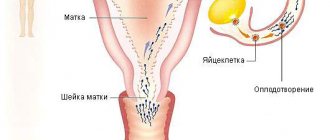Changes – what to expect?
On average, it takes 6 to 8 weeks for the vagina to fully recover after childbirth. This is exactly the time for which doctors recommend abstaining from intimacy. But if the waiting depresses you, then you can try to speed up this process by performing a number of special Kegel exercises that help train the muscles of the perineum and vagina.
But even if, at first glance, everything has returned to normal and you do not need exercises, the ban on intimate relationships must also be adhered to because it takes time for the wound surface inside the uterus, formed at the site of attachment of the placenta, to heal. If an open wound becomes infected during sex, endometritis (inflammation of the uterus) cannot be avoided.
Kegel exercises
The famous gynecologist Albert Kegel developed a system of exercises originally intended for those women who gave birth and who, after childbirth, developed problems associated with urinary incontinence. Subsequently, it turned out that these exercises not only strengthen the muscles of the perineum, but also restore blood circulation in the pelvis, increase sexual tone and even allow you to control orgasm. Therefore, by performing them, you can not only restore the vagina after childbirth, but also significantly improve sexual sensations.
In order to understand which muscles need to be trained, you need to try to stop the flow of urine while urinating. The muscles with which you did this are what we need. Now you need to learn how to tense and relax them, you need to do this quickly for 10 seconds, and rest for the same amount of time, three approaches will be enough. Another way: you need to squeeze them tightly for 30 seconds and try to hold them in this position, and then relax.
additionally As you can see, performing the exercises does not require much time or a specific place.
They can be done anywhere: on the street, at work, sitting at the computer, lying in bed, etc. And this is a big plus!
State
The vagina is the female sexual organ that undergoes significant changes during the process of childbirth. After all, it is along it that the child passes his birth path. As a result, it is injured and changes its shape. It is believed that it becomes much larger, which interferes with intimate life. The question of whether the vagina stretches after childbirth worries many young couples. In fact, there can be no cause for concern here. Almost all changes that occur to this organ in the first months after the birth of the baby are reversible.
- Stretching
This is a muscular organ, and as a child passes through it, the muscles stretch, lose their elasticity and tone, but this is a normal, natural process in such a situation. Over the course of 6-8 weeks, they will shrink and completely recover, so that the size of the vagina after childbirth does not change, it remains the same. It just loses its shape for a while.
- Edema
Which do not affect the woman’s well-being in any way and pass quickly (within the first 3-4 days after birth).
- Cracks and abrasions
After childbirth, the vagina is wide open, its walls acquire a blue-purple color due to swelling, they are completely covered with cracks and abrasions. In a couple of weeks, everything will return to normal, if there were no serious damage or injuries. The cracks will heal, the swelling will subside, and the walls will again become a pale pink shade.
- Wall relief
The relief of the vaginal walls changes, which is why the myth arose that the size of the vagina increases after childbirth. In nulliparous women, the relief is more pronounced, and in all mothers it is smoothed. Therefore, there is a feeling of an increase in the volume of this organ, which interferes with some men during intimacy. This is a fixable matter if you choose the position wisely.
A similar change in the vagina after childbirth occurs in absolutely all women. The only differences are the timing of the recovery period and a number of deviations and discomfort that may arise as a result of complications. In this case, you need to know how to act and try not to delay in seeing a doctor and taking medication.
Sensitivity, pain, dryness
Some women notice a decrease in vaginal sensitivity after childbirth. First of all, this is due to the laxity of the vaginal walls and the nerve endings that have not yet recovered. There is no need to panic. To speed up the recovery process, you can resort to performing the above exercises.
Women who suffered ruptures of the perineum or vaginal walls during childbirth that were sutured more often complain of painful sensations during intimacy. As a rule, pain occurs in the area of the suture, during the application of which a nerve ending may have been affected. But over time, the nerve adapts, and the pain no longer bothers you.
Vaginal dryness after childbirth can be explained by a decrease in estrogen levels (this is especially true for nursing mothers). This phenomenon is temporary, but in the meantime you can use moisturizing intimate lubricants that will eliminate the discomfort that appears.
Condition of the vagina in a young mother
Many couples are concerned about how serious the consequences of childbirth are for their intimate life. There are many prejudices that actually have nothing to do with the truth. There is no reason to worry, because even if the vagina is large after childbirth, this can be corrected.
Physical changes
Stretching . The vagina is a muscular organ, so as the baby passes through the birth canal, elasticity is lost, but this is a normal process. A few weeks will pass and the size will return to the same size. Even a very wide vagina will return to normal, the shape will simply be lost.
Swelling . It goes away in 3-4 days, the woman does not experience discomfort because of this.
Cracks and abrasions . Upon examination, you can see that the walls of the vagina after childbirth become blue-purple in color, cracks and abrasions are noticeable. After a couple of weeks, everything returns to its normal state. The swelling goes away, the cracks gradually heal, and the color of the vaginal walls again becomes pale pink.
Wall relief . There is a prejudice that a woman’s vagina becomes much larger in size after childbirth. But it's in its walls. For those who have not given birth, the relief is clearer, while for women who have recently given birth, it is smoothed out. Because of this, the organ appears to be enlarged. This can interfere with men during sexual intercourse, but if you choose a position, you can easily avoid unpleasant sensations.
Vaginal prolapse
It happens that the pelvic floor muscles are so weakened that they cannot support the internal organs, and vaginal prolapse occurs after childbirth. There are three types based on severity:
- Partial prolapse of one of the vaginal walls or both, but without extending beyond the vaginal opening;
- The walls of the vagina extend outward from the vaginal opening;
- Complete prolapse, often accompanied by uterine prolapse.
Important This postpartum complication in most cases requires surgical correction to strengthen the pelvic floor muscles.
To avoid such an unpleasant situation, doctors recommend performing Kegel exercises throughout pregnancy.
How the vagina changes after childbirth
Most women who give birth vaginally experience vaginal enlargement after childbirth. That is why they are looking for an answer to how to return their body to a normal state.
Why the size of the vagina becomes larger after childbirth is easily explained by the volume of the baby's head. The baby passes through the birth canal and stretches its muscles, thus making its way into the world. Some babies are born with a lot of weight, and this puts a huge strain on the pelvic muscles. Doctors often make incisions to avoid ruptures.
The first time after childbirth, the vagina remains stretched, the lumen of the cervical canal opens to two fingers. It recovers for several weeks, and after three months it finally returns to normal. But the vagina before and after childbirth is not always the same picture. If an incision was made, recovery may take longer.
Unfounded fear
Often women after childbirth refuse intimacy, fearing that childbirth has changed the size of the vagina and now they will not be able to get pleasure or their spouse will be unhappy. But don't rush to hasty conclusions! Many women claim that sex after childbirth was “like the first time,” while men do not find any differences at all.
However, there are many reasons for reluctance to have sex, this could be fatigue, postpartum depression, a feeling of one’s own unattractiveness, fear that the child will wake up at the wrong moment, or a new pregnancy will occur.
The reasons can be either obvious or lying deep in the subconscious. But you can cope with both!
The appearance of a baby in the family makes huge changes in the relationships of young spouses, including intimate ones. There is no need to hide from fears, you need to fight them!
Useful video about what happens to intimate muscles during childbirth and how to restore them
All pregnant women understand that the vagina will change its shape and size after childbirth. This is natural, because it must stretch in a certain way to allow the baby to be born. But not all young mothers know how and how quickly the vagina is restored after childbirth, and whether sensations change during intimacy with a spouse.
Like all organs of the female body, the vagina also recovers some time after childbirth, although in some cases not as quickly as we would like. Since it consists of muscles, all changes that occur during childbirth are reversible, but the speed of recovery largely depends on the individual physiology of the woman. According to medical statistics, approximately half of women in labor experience discomfort during sexual relations during the first 2.5–3 months after the birth of a child. For about a fifth of women, discomfort lasts up to a year.
Possible deviations
Rehabilitation after childbirth
After the birth of a child, a woman’s vagina undergoes various types of complications. It is necessary to restore it so that consequences do not appear. In more serious situations, surgery is required. It is important for a woman not only to give birth, but also to rehabilitate herself in a short period of time.
Reduced sensitivity
During labor, the vaginal walls become flabby. The sensitivity of nerve endings is also impaired. A woman should not be afraid; after a while everything will recover on its own.
Pain syndrome
Postpartum pain syndrome
Many young mothers experience pain in the vaginal area. Some people feel them weaker, but there are those for whom they manifest themselves more intensely. In most cases, the main cause is a rupture of the walls or perineum. When a doctor stitches up the vaginal tissue, the process affects the nerve endings. This provokes the appearance of pain syndrome. When the recovery period is over, the nerve adapts, discomfort and pain will no longer bother the woman.
Dryness
This is the most unpleasant symptom that occurs in those giving birth after the birth of the baby. The complication is explained by a reduced level of the hormone estrogen. Women encounter a similar phenomenon during breastfeeding. After a short period of time everything passes.
Itching
One of the common problems that does not go away on its own. The help of a qualified specialist is required. Itching may be the cause of an allergic reaction to the materials used for stitching fabrics. Also, this may be a negative effect of the antiseptic, which is often used during the delivery process.
If a woman experiences itching, a consultation with her doctor is required. He will conduct an examination, a medical examination, determine the exact cause of the complication and prescribe effective treatment. If itching is accompanied by additional unpleasant symptoms, such as discharge or odor, there is a risk of developing an inflammatory process.
Omission
Treatment of uterine prolapse
Sometimes the vaginal muscles are so weak that they cannot support the organs of the female reproductive system. Against the background of such disorders, prolapse occurs, which differs in stages of severity:
- Partial. The walls of the vagina do not descend beyond its boundaries.
- External protrusion.
- Complete loss.
This is the most serious vaginal disorder a woman can have. To restore the muscular structure of the pelvic floor, qualified specialists prescribe surgical intervention to their patients.
Unpleasant smell
This complication occurs against the background of a serious inflammatory process. Sometimes rotting of the seams can cause this unpleasant symptom. The smell is rotten, musty, accompanied by itching and characteristic discharge. Self-medication in this situation can be dangerous. It is necessary to consult a gynecologist and undergo effective treatment with medications.
Discharge
After childbirth, a woman develops a specific discharge. This is postpartum mucus, consisting of dead tissue and cells. In medicine, such discharge is called lochia, which is observed in a woman for 7-8 weeks.
Any complications of the vagina after childbirth are restored. If you consult a doctor in a timely manner, he will tell you why the problem arose and how to fix it.
How long can recovery take?
The degree of change in the female genital organ depends on how difficult or easy the birth was. Provided there are no serious damage to the mucosa, ruptures or incisions, complete recovery takes about two months. It is during this period that doctors recommend providing the uterus with complete rest.
If the baby was born dense enough, the vaginal muscles are stretched to a greater extent. In this case, complete restoration of the size and shape of the organ will occur in 3-4 months.
With severe damage to muscle tissue (from tears and episiotomy), recovery may take a year. However, this is not a reason to be upset, because every woman can help her body get back into shape and significantly reduce the above-mentioned time frame.
We will look at several ways to reduce the size of the vagina in our article, and only a gynecologist will tell you during an examination when you can begin active actions.
How is the operation performed?
By itself, it does not take more than an hour and is not considered difficult for experienced doctors. After staying in the hospital for only three hours, you can return home. General anesthesia is needed so that the patient sleeps and does not feel pain. Thanks to modern drugs, such pain relief does not affect the functioning of the brain and other important organs.
Within forty minutes the woman comes to her senses, as the drug is completely eliminated from the body.
Before surgery, you need to take some tests: sometimes a gynecological smear, a general blood test, a blood test for sexually transmitted diseases and hepatitis, and an ECG. The patient's blood clotting is also checked. After the operation, the patient should lie down more during the day, move less and not lift anything heavy at all. The gentle regime lasts about three days.
If the operation was complex and long, then the woman may stay in the clinic for some time.
The only extremely serious disadvantage of vaginoplasty is that after it you cannot sit down for about three to four weeks. Even taking into account the fact that the external surgical wound quickly heals, a woman should not take a sitting position, since the sutures on the muscles can come apart at any time. This is due to the fact that, unfortunately, they completely grow together only after this period has passed. However, the problem is easily solved; there are special “orthopedic circles” on which you can sit without restrictions, even while driving and, for example, on an airplane.










